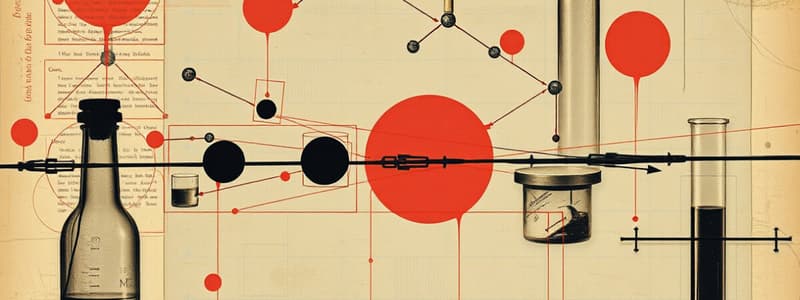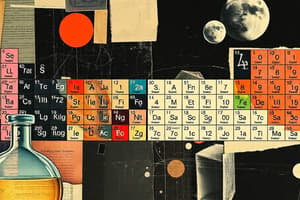Podcast
Questions and Answers
What effect does adding solute have on the freezing point of a solution?
What effect does adding solute have on the freezing point of a solution?
- It raises the freezing point.
- It keeps the freezing point the same.
- It alters the composition of the solvent.
- It lowers the freezing point. (correct)
Which factor is not included when calculating the solubility product constant (Ksp) for a salt like NaCl?
Which factor is not included when calculating the solubility product constant (Ksp) for a salt like NaCl?
- Concentration of Na+ ions.
- Concentration of solid NaCl. (correct)
- Concentration of Cl- ions.
- Concentration of water.
In the ideal gas law, if gas X has twice the pressure of gas Y, what can be inferred about their volumes?
In the ideal gas law, if gas X has twice the pressure of gas Y, what can be inferred about their volumes?
- V1 is equal to V2.
- V1 is equal to twice V2.
- V1 is less than V2. (correct)
- V1 is greater than V2.
What is the definition of molality in the context of freezing point depression?
What is the definition of molality in the context of freezing point depression?
What is the outcome of a phase change like aluminum melting from solid to liquid?
What is the outcome of a phase change like aluminum melting from solid to liquid?
Which statement correctly describes the trend in first ionization energy across the periodic table?
Which statement correctly describes the trend in first ionization energy across the periodic table?
What is the result of adding a strong acid to a saturated solution of Mg(OH)2?
What is the result of adding a strong acid to a saturated solution of Mg(OH)2?
What indicates a spontaneous reaction at all temperatures?
What indicates a spontaneous reaction at all temperatures?
In the formula for osmotic pressure, what does the variable R represent?
In the formula for osmotic pressure, what does the variable R represent?
In the context of redox reactions, what happens to aluminum in the reaction 2 Al2O3 + 3 C → 4 Al + 3 CO2?
In the context of redox reactions, what happens to aluminum in the reaction 2 Al2O3 + 3 C → 4 Al + 3 CO2?
What does a decrease in bond angles in molecules primarily result from?
What does a decrease in bond angles in molecules primarily result from?
Which of the following is true regarding conjugate acid-base pairs?
Which of the following is true regarding conjugate acid-base pairs?
What effect does increasing temperature have on the movement of molecules in a system?
What effect does increasing temperature have on the movement of molecules in a system?
What is the variable 'Kf' in the formula for freezing point depression?
What is the variable 'Kf' in the formula for freezing point depression?
Adding solute to a solvent increases the freezing point of the solution.
Adding solute to a solvent increases the freezing point of the solution.
What does the term 'molarity' refer to in the context of solutions?
What does the term 'molarity' refer to in the context of solutions?
In the ideal gas law, if the pressure of gas X is twice that of gas Y, then V1 will be equal to __________.
In the ideal gas law, if the pressure of gas X is twice that of gas Y, then V1 will be equal to __________.
Match the following gas law terms with their descriptions:
Match the following gas law terms with their descriptions:
Which of the following is true regarding first ionization energy?
Which of the following is true regarding first ionization energy?
An increase in the temperature of a system results in a decrease in entropy.
An increase in the temperature of a system results in a decrease in entropy.
What does the Gibbs Free Energy equation indicate when ΔH < 0 and ΔS > 0?
What does the Gibbs Free Energy equation indicate when ΔH < 0 and ΔS > 0?
In the reaction Mg(OH)2(s) ⇌ Mg2+(aq) + 2OH−(aq), adding a strong acid drives the equilibrium towards the formation of more _____ ions.
In the reaction Mg(OH)2(s) ⇌ Mg2+(aq) + 2OH−(aq), adding a strong acid drives the equilibrium towards the formation of more _____ ions.
Match the thermodynamic laws with their correct units:
Match the thermodynamic laws with their correct units:
What is the significance of a polar covalent bond?
What is the significance of a polar covalent bond?
The freezing point of pure water is 0°F.
The freezing point of pure water is 0°F.
What happens to OH- ions when a strong acid is added to a saturated solution of Mg(OH)2?
What happens to OH- ions when a strong acid is added to a saturated solution of Mg(OH)2?
Flashcards are hidden until you start studying
Study Notes
Ionization Energy
- First ionization energy rises in the periodic table, moving up and to the right.
- It measures the energy needed to detach the first electron from a neutral atom.
- Increased effective nuclear charge enhances attraction from protons, making ionization more challenging.
Chemical Reactions and Equilibria
- Adding a strong acid to a saturated Mg(OH)₂ solution elevates Mg²⁺ ion concentration as OH⁻ ions react with H⁺ to form water.
- Reaction equation: Mg(OH)₂(s) ⇌ Mg²⁺(aq) + 2OH⁻(aq).
Thermodynamic Laws and Units
- Zeroth Law units: M¹s⁻¹.
- First Law units: s⁻¹.
- Second Law units: M⁻¹s⁻¹.
- Third Law units: M⁻²s⁻¹.
Gibbs Free Energy and Spontaneity
- ΔH > 0 and ΔS < 0 indicates a non-spontaneous reaction.
- ΔH < 0 and ΔS < 0 shows spontaneity at low temperatures.
- ΔH > 0 and ΔS > 0 denotes spontaneity at high temperatures.
- ΔH < 0 and ΔS > 0 signifies spontaneity under all temperatures.
Osmotic Pressure
- Osmotic pressure formula: π = iMRT, with R = 0.082 (L × atm)/(mol × K).
Bonding and Electronegativity
- Polar covalent bonds form when electronegative nonmetals bond with less electronegative nonmetals, exemplified by HCl.
- High electronegativity of chlorine causes uneven electron sharing, creating a dipole.
Entropy and Temperature
- Rising temperature boosts molecular movement, increasing system entropy.
- Changes in temperature, volume, and pressure are linked to alterations in entropy (ΔS).
Factors Affecting Bond Angles
- Lone pairs exert greater repulsion than bonding pairs, reducing bond angles in molecules.
Redox Reactions
- In the reaction 2 Al₂O₃ + 3 C → 4 Al + 3 CO₂, aluminum in Al₂O₃ is reduced and carbon is oxidized.
- Understanding oxidation states helps identify redox processes.
Acid-Base Chemistry
- Conjugate pairs connect an acid to its related base.
- An acid loses a proton (H⁺) to create its conjugate base, while a base gains a proton to become its conjugate acid.
Properties of Water
- Freezing and melting points of pure water: 0°C / 32°F / 273K.
- At 0°C, pure water can exist as both liquid and solid, contingent on heat exchange.
Freezing Point Depression
- Freezing point depression formula: ΔTf = -(i × Kf × m), with m being molality (moles of solute per kg of solvent).
- The addition of solute decreases the freezing point; the more particles present, the greater the depression.
Changes of State
- Physical changes maintain the chemical formula, exemplified by aluminum transitioning from solid to liquid.
Solubility Product Constant (Ksp)
- To find Ksp for NaCl in water, consider the concentrations of Na⁺ and Cl⁻, as solids and pure liquids are not included in equilibrium expressions.
Ideal Gas Law
- For ideal gases X and Y at the same temperature and molecule count, pressure and volume relationship is expressed as P1V1 = P2V2.
- If gas X's pressure is double that of gas Y, then V1 equals half of V2.
Ionization Energy
- First ionization energy rises in the periodic table, moving up and to the right.
- It measures the energy needed to detach the first electron from a neutral atom.
- Increased effective nuclear charge enhances attraction from protons, making ionization more challenging.
Chemical Reactions and Equilibria
- Adding a strong acid to a saturated Mg(OH)₂ solution elevates Mg²⁺ ion concentration as OH⁻ ions react with H⁺ to form water.
- Reaction equation: Mg(OH)₂(s) ⇌ Mg²⁺(aq) + 2OH⁻(aq).
Thermodynamic Laws and Units
- Zeroth Law units: M¹s⁻¹.
- First Law units: s⁻¹.
- Second Law units: M⁻¹s⁻¹.
- Third Law units: M⁻²s⁻¹.
Gibbs Free Energy and Spontaneity
- ΔH > 0 and ΔS < 0 indicates a non-spontaneous reaction.
- ΔH < 0 and ΔS < 0 shows spontaneity at low temperatures.
- ΔH > 0 and ΔS > 0 denotes spontaneity at high temperatures.
- ΔH < 0 and ΔS > 0 signifies spontaneity under all temperatures.
Osmotic Pressure
- Osmotic pressure formula: π = iMRT, with R = 0.082 (L × atm)/(mol × K).
Bonding and Electronegativity
- Polar covalent bonds form when electronegative nonmetals bond with less electronegative nonmetals, exemplified by HCl.
- High electronegativity of chlorine causes uneven electron sharing, creating a dipole.
Entropy and Temperature
- Rising temperature boosts molecular movement, increasing system entropy.
- Changes in temperature, volume, and pressure are linked to alterations in entropy (ΔS).
Factors Affecting Bond Angles
- Lone pairs exert greater repulsion than bonding pairs, reducing bond angles in molecules.
Redox Reactions
- In the reaction 2 Al₂O₃ + 3 C → 4 Al + 3 CO₂, aluminum in Al₂O₃ is reduced and carbon is oxidized.
- Understanding oxidation states helps identify redox processes.
Acid-Base Chemistry
- Conjugate pairs connect an acid to its related base.
- An acid loses a proton (H⁺) to create its conjugate base, while a base gains a proton to become its conjugate acid.
Properties of Water
- Freezing and melting points of pure water: 0°C / 32°F / 273K.
- At 0°C, pure water can exist as both liquid and solid, contingent on heat exchange.
Freezing Point Depression
- Freezing point depression formula: ΔTf = -(i × Kf × m), with m being molality (moles of solute per kg of solvent).
- The addition of solute decreases the freezing point; the more particles present, the greater the depression.
Changes of State
- Physical changes maintain the chemical formula, exemplified by aluminum transitioning from solid to liquid.
Solubility Product Constant (Ksp)
- To find Ksp for NaCl in water, consider the concentrations of Na⁺ and Cl⁻, as solids and pure liquids are not included in equilibrium expressions.
Ideal Gas Law
- For ideal gases X and Y at the same temperature and molecule count, pressure and volume relationship is expressed as P1V1 = P2V2.
- If gas X's pressure is double that of gas Y, then V1 equals half of V2.
Studying That Suits You
Use AI to generate personalized quizzes and flashcards to suit your learning preferences.




